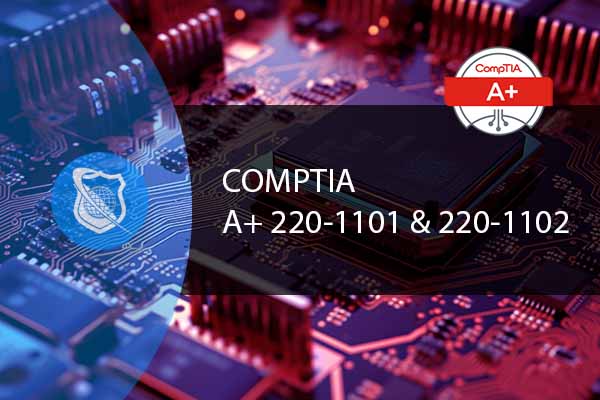If you’re in the IT industry, you’ve likely heard of the CompTIA A+ Certificate. This certification is more than just a piece of paper; it’s a cornerstone for anyone looking to build a solid career in information technology. With over two decades of hands-on experience, I can tell you that mastering the art of software troubleshooting is not just a skill—it’s a necessity. In this sixth installment of our 9-part series, we’ll delve deep into the critical aspect of software troubleshooting. This blog aims to be your comprehensive A+ Troubleshooting Guide, covering a wide array of topics from CompTIA A+ Diagnostic Tools to Software Troubleshooting Techniques and A+ Software Repair. So, whether you’re a novice or a seasoned professional, this guide will offer valuable insights into the world of IT troubleshooting.
| Domain | Description |
|---|---|
| 01 – Hardware | Computer components and troubleshooting |
| 02 – Networking | Networking concepts and troubleshooting |
| 03 – Mobile Devices | Mobile device hardware and troubleshooting |
| 04 – Hardware & Network Troubleshooting | Diagnosing and resolving issues |
| 05 – Operating Systems | OS features, installation, and management |
| 06 – Software Troubleshooting | Common software issues and solutions |
| 07 – Security | Basic security concepts and practices |
| 08 – Virtualization & Cloud | Introduction to virtualization and cloud |
| 09 – Operational Procedures | IT best practices and procedures |

CompTIA A+ Course
Embark on a transformative journey into the world of IT with our CompTIA A+ Certification course. From mastering hardware and network devices to software troubleshooting and security procedures, this comprehensive course equips you with the skills to excel in the ever-evolving tech landscape. Take the next step in your career and prepare for the CompTIA A+ exams!
The Importance of Software Troubleshooting
Why Troubleshooting Matters
In today’s digital age, software issues are as inevitable as death and taxes. Whether you’re dealing with a minor glitch that’s an annoyance or a major system failure that can cripple a business, the ability to diagnose and fix these problems is invaluable. This skill set is not just a nice-to-have but a must-have, especially for those holding a CompTIA A+ Certificate. The certification’s curriculum places a heavy emphasis on A+ Software Problem-Solving, teaching you how to navigate through CompTIA A+ Software Issues effectively.
The Role of CompTIA A+ in Software Troubleshooting
When you earn your CompTIA A+ Certificate, you’re not just getting a credential; you’re gaining a toolkit filled with problem-solving skills. This certification equips you with the necessary knowledge to tackle a wide range of software issues. From understanding CompTIA A+ Operating Systems to decoding CompTIA A+ Error Codes, the A+ certification provides a holistic approach to problem-solving in the IT world.
But it doesn’t stop there. The certification also covers A+ Software Repair techniques, teaching you how to get under the hood of a system to make precise, effective fixes. You’ll learn about A+ Software Configuration, CompTIA A+ Best Practices, and even how to handle CompTIA A+ Boot Issues. This comprehensive training ensures that you’re well-equipped to diagnose and resolve software problems, making you an invaluable asset in any IT environment.
CompTIA A+ Diagnostic Tools
Built-in Tools
Most modern operating systems come equipped with a variety of built-in CompTIA A+ Diagnostic Tools that can help you identify and resolve software and hardware issues. These tools range from simple command-line utilities, like the Windows Command Prompt or macOS’s Terminal, to more complex graphical interfaces that offer a user-friendly experience. For example, Windows has its built-in “Troubleshooters,” and macOS offers “Disk Utility” for basic disk management and repair.
Mastering these built-in utilities is not just a recommendation; it’s part of the CompTIA A+ Best Practices. These tools can help you diagnose CompTIA A+ Software Issues, A+ Software Configuration problems, and even CompTIA A+ Boot Issues without requiring any third-party software. Therefore, understanding how to utilize these built-in tools effectively is crucial for anyone aiming to excel in IT troubleshooting.
Third-Party Tools
While built-in utilities offer a good starting point, sometimes you need a more specialized approach. That’s where third-party CompTIA A+ Certificate Diagnostic Tools come into play. These tools often provide more advanced features, such as deep system scans, comprehensive error reports, and even remote troubleshooting capabilities. Software like “Sysinternals Suite” for Windows or “OnyX” for macOS can be invaluable in a professional IT setting.
These third-party tools are particularly useful for more complex A+ Software Repair tasks and can be a lifesaver when dealing with stubborn CompTIA A+ Software Issues. Therefore, familiarizing yourself with reputable third-party diagnostic tools is also in line with CompTIA A+ Best Practices.
Software Troubleshooting Techniques
The Process of Elimination
One of the most effective Software Troubleshooting Techniques is the process of elimination. This method involves identifying the symptoms of the issue at hand and then systematically ruling out potential causes one by one. For example, if a program isn’t launching as it should, you might first check if the issue is with the CompTIA A+ Certificate Software Configuration, then move on to possible CompTIA A+ Software Compatibility issues, and so on.
This approach is particularly useful for diagnosing CompTIA A+ Software Issues that are not immediately obvious. By eliminating variables, you can zero in on the root cause more efficiently, making the process of elimination a cornerstone technique in A+ Software Problem-Solving.

CompTIA A+ Course
Embark on a transformative journey into the world of IT with our CompTIA A+ Certification course. From mastering hardware and network devices to software troubleshooting and security procedures, this comprehensive course equips you with the skills to excel in the ever-evolving tech landscape. Take the next step in your career and prepare for the CompTIA A+ exams!
A+ Software Solutions: The Repair Process
Once you’ve identified the root cause of the issue, the next logical step is to repair it. A+ Software Repair is often a multi-step process that may involve a variety of actions, such as reinstalling the problematic software, updating A+ Software Drivers, or modifying configuration files. Each of these steps should be carried out methodically and carefully to ensure that the issue is fully resolved and doesn’t recur.
For instance, if you’ve determined that outdated drivers are causing a software malfunction, you would first uninstall the current drivers before installing the updated versions. This systematic approach to CompTIA A+ Certificate Software Solutions ensures that you’re not just putting a band-aid on the problem but are resolving it at its core.
Dealing with Specific Software Issues
CompTIA A+ Error Codes
When you’re troubleshooting, encountering CompTIA A+ Error Codes can be both a curse and a blessing. While they indicate that something has gone wrong, these error codes also serve as vital clues for diagnosing the issue. For instance, a “404 error” typically means a webpage wasn’t found, while a “503 error” often indicates service unavailability. These codes can guide you in pinpointing the root cause, whether it’s related to A+ Software Configuration, CompTIA A+ Software Compatibility, or other CompTIA A+ Software Issues.
Understanding these error codes is not just beneficial; it’s crucial for effective troubleshooting. They provide insights into what went wrong and can guide you in resolving the issue methodically. Therefore, mastering the interpretation of CompTIA A+ Error Codes is a key aspect of A+ Software Problem-Solving and is in line with CompTIA A+ Best Practices.
A+ Software Configuration and Compatibility
One of the most common sources of software issues is incorrect CompTIA A+ Certificate Software Configuration or compatibility problems. For example, running software that’s not compatible with your operating system can lead to crashes, errors, and other CompTIA A+ Software Issues. Similarly, incorrect configuration settings can result in performance issues, connectivity problems, and even data loss.
Ensuring that your software is compatible with your operating system and hardware is not just a one-time task; it’s an ongoing responsibility. Regular checks and updates can save you a lot of headaches down the line and are considered part of A+ Software Maintenance.
Advanced Troubleshooting
CompTIA A+ Malware Removal
In today’s interconnected world, malware has become a significant cause of software issues. From slowing down your system to causing data breaches, the impact of malware can be devastating. Being proficient in CompTIA A+ Malware Removal techniques is not just a skill; it’s a necessity for maintaining a secure and stable computing environment.
Whether it’s using built-in security features of an operating system or third-party antivirus software, CompTIA A+ Malware Removal involves a series of steps aimed at identifying, isolating, and eliminating malicious software. This skill is essential for anyone holding a CompTIA A+ Certificate and is a crucial part of A+ Software Repair.
A+ Software Updates and Maintenance
Regular CompTIA A+ Certificate Software Updates and A+ Software Maintenance are not just recommended practices; they’re crucial for keeping your systems running smoothly. Software updates often contain fixes for known issues, performance improvements, and sometimes, new features. Failing to update your software can leave your system vulnerable to security risks and performance issues.
Moreover, regular maintenance activities like disk cleanup, defragmentation, and system scans are essential for preventing problems before they occur. These tasks are part of CompTIA A+ Software Maintenance and are essential for anyone looking to excel in IT troubleshooting.

CompTIA A+ Course
Embark on a transformative journey into the world of IT with our CompTIA A+ Certification course. From mastering hardware and network devices to software troubleshooting and security procedures, this comprehensive course equips you with the skills to excel in the ever-evolving tech landscape. Take the next step in your career and prepare for the CompTIA A+ exams!
Recovery and Backup
CompTIA A+ Recovery Methods
Despite our best efforts, there are times when troubleshooting hits a wall, and the only viable option is to recover the system. Knowing various CompTIA A+ Recovery Methods can be a lifesaver in such situations. These methods range from using built-in recovery options like “System Restore” in Windows or “Time Machine” in macOS, to employing third-party tools designed for data recovery and system restoration.
Being prepared with a set of recovery methods can make a world of difference when you’re in a tight spot. Whether it’s recovering lost data or restoring your system to a previous state, these CompTIA A+ Recovery Methods offer a safety net that every IT professional should be familiar with.
CompTIA A+ Certificate Software Drivers and Installation
Sometimes, the root of the problem may lie with outdated or corrupt drivers. Drivers act as the bridge between your software and hardware, and if they’re not functioning correctly, it can lead to a host of CompTIA A+ Software Issues. Understanding how to properly install and update A+ Software Drivers is an essential skill for anyone holding a CompTIA A+ Certificate.
Whether it’s a printer that won’t print or a display that’s acting up, knowing how to locate, install, and update the right drivers can often resolve these issues. This skill is a crucial part of A+ Software Maintenance and A+ Software Repair.
Conclusion for CompTIA A+ Certificate Software Troubleshooting
Software troubleshooting is an integral part of the CompTIA A+ Certificate curriculum and a vital skill for anyone in the IT industry. From understanding CompTIA A+ Diagnostic Tools to mastering Software Troubleshooting Techniques, this blog has aimed to be your go-to A+ Troubleshooting Guide. With these skills under your belt, you’ll be well-equipped to tackle any software issue that comes your way, from CompTIA A+ Software Issues to CompTIA A+ Certificate Software Configuration challenges.
Remember, the key to effective troubleshooting is a methodical approach, backed by a solid understanding of CompTIA A+ Best Practices. Whether it’s employing CompTIA A+ Recovery Methods or updating A+ Software Drivers, being prepared and knowledgeable is half the battle won.
So the next time you encounter a software issue, you’ll know exactly what to do. Happy troubleshooting!
CompTIA A+ Certification Software Troubleshooting FAQ
What common software issues are covered in the CompTIA A+ certification?
The CompTIA A+ certification thoroughly addresses a range of software troubleshooting topics, including operating system errors, software application issues, driver conflicts, and security vulnerabilities. It equips candidates with the knowledge to diagnose and resolve these issues effectively, ensuring systems run smoothly and securely.
How does the CompTIA A+ certification prepare you for real-world software troubleshooting?
The certification offers practical, hands-on experience and problem-solving strategies for dealing with software problems. Through study materials and exam questions, candidates learn to troubleshoot operating system issues, manage software installations, and configure security settings, equipping them with the skills needed for real-world IT support roles.
Are there any prerequisites for tackling the software troubleshooting section of the CompTIA A+ exam?
While there are no formal prerequisites, it’s beneficial to have a basic understanding of computer systems and operating systems. Familiarity with different software environments, such as Windows, macOS, and Linux, can also help. The CompTIA IT Fundamentals (ITF+) certification is a good starting point for absolute beginners.
What resources are recommended for studying the software troubleshooting aspects of the CompTIA A+ exam?
Candidates should explore a variety of study resources, including the official CompTIA A+ study guide, online courses, practice exams, and community forums. These resources provide comprehensive coverage of software troubleshooting topics, from identifying symptoms to implementing solutions.
Can CompTIA A+ certification software troubleshooting skills be applied to both desktop and mobile operating systems?
Yes, the skills gained from the CompTIA A+ certification are applicable to a wide range of devices, including desktops, laptops, and mobile devices. The principles of software troubleshooting remain consistent across different platforms, although the specific steps may vary depending on the operating system.

CompTIA A+ Course
Embark on a transformative journey into the world of IT with our CompTIA A+ Certification course. From mastering hardware and network devices to software troubleshooting and security procedures, this comprehensive course equips you with the skills to excel in the ever-evolving tech landscape. Take the next step in your career and prepare for the CompTIA A+ exams!
Explore Our Comprehensive 9-Part Series on CompTIA Network+ Exam Domains
Dive deep into the world of networking with our extensive 6-part blog series designed to be your ultimate guide for the CompTIA A+ Exam. Each blog focuses on a specific domain, providing expert insights, study tips, and real-world applications to help you master the subject and ace the exam. Click on the titles below to explore each domain in detail.
CompTIA A+ Hardware : A Comprehensive Domain Overview (1 of 9 Part Series)
CompTIA A+ Networking: Unveiling the Essentials of the Domain (2 of 9 Part Series)
Mobile Devices CompTIA A+ : Understanding the Domain (3 of 9 Part Series)
CompTIA A+ Hardware and Network Troubleshooting: A Comprehensive Domain Guide (4 of 9 Part Series)
CompTIA A+ Operating Systems : Deep Dive Into The Domain (5 of 9 Part Series)
CompTIA A+ Certificate : Software Troubleshooting (6 of 9 Part Series)
CompTIA A+ Security : A Deep Dive Into The Domain Fundamentals (7 of 9 Part Series)
CompTIA A+ Cloud Computing and Virtualization: A Comprehensive Domain Guide (8 of 9 Part Series)
CompTIA A+ Operational Procedures: A Deep Dive into the Domain (9 of 9 Part Series)

























10 thoughts on “CompTIA A+ Certificate : Software Troubleshooting (6 of 9 Part Series)”
Thanks, great article
Really appreciated your deep dive. It’s exciting to see how these updates can streamline coding processes and enhance efficiency.
Your style is so unique compared to other people I have read stuff from.
Many thanks for posting when you’ve got the opportunity,
Guess I’ll just bookmark this site.
Networking is a fundamental aspect of IT, and this series appears to be a great resource for beginners. Excited to delve deeper into the essentials!
Troubleshooting software issues is a valuable skill in IT. I’m glad to see a comprehensive series on this topic. Can’t wait to explore more!
Glad to be one of the visitors of this great web site :D.
This article on software troubleshooting is a lifesaver for CompTIA A+ aspirants. The step-by-step guidance and real-world examples make it much easier to grasp the concepts. Kudos to the author for simplifying a complex topic!
WOW, this series was very helpful for me and just picked up your course.
These sets of articles are so freaking helpful! I was a bit lost and now I have a much better handle on what I need to do for A+!
There is noticeably a bundle to know about this. I assume you made certain nice points in features also.